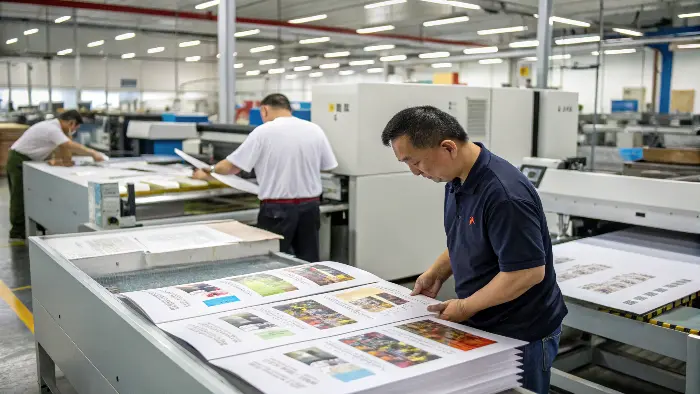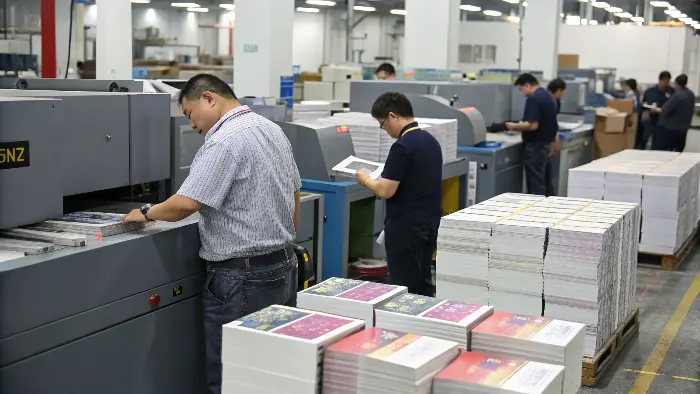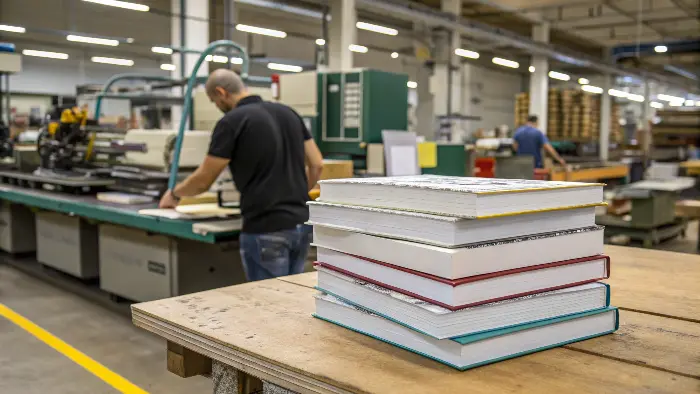Struggling to find reliable book manufacturing? Worried about quality from China? I get it, finding the right partner feels overwhelming. Let’s clear things up.
Book manufacturing in China involves robust quality standards like ISO 9001 and detailed production processes, from material sourcing to final checks. Chinese manufacturers can produce high-quality books, especially when you partner with experienced suppliers who prioritize quality control at every step.
So, you’re curious about how books actually come to life in China, right? It’s a question I hear a lot, especially from buyers like Michael, who are always on the lookout for that perfect blend of quality, design, and reliability. It’s not just about hitting "print." There’s a whole world behind that crisp new book in your hands. Trust me, I’ve seen it firsthand, and it’s pretty fascinating. If you stick around, I’ll walk you through the essentials, so you know exactly what to expect.
What Raw Materials Are Actually Needed for Book Production in China?
Ever wonder what goes into a book, beyond the story? Choosing materials is tricky. Get it wrong, and your whole project suffers. Let’s break down the basics.
Key raw materials for book production include various paper types (like silk, gloss, or uncoated art paper), printing inks (CMYK, Pantone), binding adhesives, and cover materials. The choice impacts the book’s look, feel, durability, and cost.
When we talk about making books, especially here at Panoffices where we aim for "Smart Stationery, Better Work," the materials are king. It’s not just paper and ink, though those are super important. Think about the paper first. You’ve got options like coated art paper, which can be gloss or matte – great for vibrant images in art books or high-end catalogs. Then there’s uncoated wood-free paper, often used for novels or journals, giving a more classic, tactile feel. We also see a lot of demand for silk paper, which is a nice in-between. And let’s not forget offset paper, a workhorse for many printing jobs.
The inks? Oh yeah, they matter too. Standard is CMYK (Cyan, Magenta, Yellow, Key/Black) for full-color printing. But sometimes, for specific brand colors, we use Pantone (PMS) inks. Binding glues are critical – you don’t want pages falling out! We often use PUR (Polyurethane Reactive) glue for its strength and flexibility, especially for perfect-bound books. For hardcover books, you’ve got cover boards, endpapers, and often cloth or special paper for the cover itself. I remember one client, a German company much like Michael’s, was so particular about the texture of the cover material for their notebooks. We sourced so many samples! It’s these details that make a difference. And hey, this attention to material quality is a big part of ensuring we meet international standards.
So, What is the Overall Manufacturing Process of a Book in China?
| Feeling lost in the steps of book making? It seems complex, right? But understanding the flow is key to a smooth project. I’ll simplify it for you. The book manufacturing process includes pre-press (design, proofing), printing (offset or digital), binding (sewing, gluing), finishing (lamination, embossing), and strict quality control. Each stage ensures the final book meets your specifications and quality expectations.  Okay, let’s walk through how a book is born, from idea to your hands. It’s a bit like a well-conducted orchestra, really. First up is Pre-Press. This is where all the digital magic happens. Your manuscript gets designed, typeset, and proofed. We’re talking meticulous checks – making sure every comma is right, every image is sharp. This stage is crucial, and it’s where standards like ISO 9001 really start to show their worth in systematic checks. I once had a project where a tiny error in the pre-press stage almost derailed a huge order of planners. Luckily, our eagle-eyed team caught it! Phew. Next, we move to Printing. This is where the pages actually get inked. Most large runs use offset printing, which is super efficient for high volumes and gives fantastic quality. For smaller runs or personalized books, digital printing is a great option. Then comes Binding. This is where loose printed sheets become a book. You’ve got different styles: perfect binding (like most paperbacks), saddle-stitching (for thin booklets), and case binding (for hardcovers). Each has its place. Finally, there’s Finishing and Quality Control. This includes things like lamination for covers, maybe some embossing or foil stamping to make it pop. And then, rigorous checks. Every stage, especially here in China where we aim for global markets, has quality control points. We ensure everything aligns with what the client, say someone like Michael from Germany, expects. It’s all about consistent quality from start to finish. |
Stage | Key Activities | Quality Focus |
|---|---|---|---|
| 1. Pre-Press | Design, Typesetting, Proofing, Plate-making | Accuracy, Layout, Color Matching | |
| 2. Printing | Offset/Digital Printing, Ink & Paper Management | Print Clarity, Color Consistency | |
| 3. Binding | Folding, Gathering, Sewing/Gluing, Trimming | Strength, Page Order, Alignment | |
| 4. Finishing | Lamination, Embossing, Foiling, Die-cutting | Aesthetic Appeal, Durability | |
| 5. QC & Packing | Final Inspection, Counting, Boxing, Shipping Prep | Overall Quality, Adherence to Specs |
This structured approach, honestly, is what helps us at Panoffices deliver.
How Exactly Are Books Printed in China, and What About Quality?
Worried if "Made in China" means cutting corners on print quality? It’s a common fear. But the reality might surprise you. Let’s look closer.
Books in China are printed using advanced offset and digital technologies. Reputable manufacturers adhere to international (ISO 9001) and national (GB) standards, with strict quality control at pre-press, on-press, and post-press stages to ensure high-quality, professional results.

When people ask me how books are printed in China, they’re often really asking about quality. And I get it. There are all sorts of stories out there. But here’s the thing: modern Chinese printing facilities are often incredibly advanced. We’re talking cutting-edge offset presses from Heidelberg or Komori, and sophisticated digital printing setups for shorter runs or variable data. I’ve walked through so many of these plants, and honestly, they are impressive.
The process starts with meticulous pre-press checks. Digital proofs, sometimes even physical mock-ups, are created to ensure everything is perfect before a single plate is made. Once printing begins, on-line quality monitoring is common. Think densitometers checking ink consistency, automated systems flagging imperfections. It’s not just about churning out pages; it’s about precision. Chinese manufacturers who export, like the partners we work with at Panoffices, are very aware of international expectations. They often comply with ISO 9001, which is a big deal for systematic quality management. Plus, there are China’s own GB (Guobiao) standards for specific aspects. We also pay close attention to material quality – the paper, as I mentioned before, plays a huge role. Using good quality silk paper, or a specific gloss paper as requested, makes a world of difference. It’s this combination of technology, process, and commitment to standards that allows us to consistently deliver books that meet the high expectations of clients like Michael in Europe. It’s a far cry from the old stereotypes, believe me. 🔥
Why Are Books Often Perceived as Being So Cheap to Make in China?
Heard that books from China are always super cheap? Wondering if that means sacrificing quality? It’s a bit more complex than just the price tag. Let’s unpack this.
Books can be cost-effective to produce in China due to economies of scale, efficient supply chains, advanced manufacturing technology, and competitive labor for skilled tasks. However, "cheap" doesn’t equate to low quality; reputable suppliers prioritize quality standards.

Ah, the big question: why are books often cheaper to produce in China? It’s a common topic, and sometimes it makes buyers a bit nervous, thinking "cheap" must mean "low quality." But that’s not the whole story, not by a long shot. One major factor is economies of scale. Chinese manufacturers often handle massive print runs. I mean, truly huge. This volume drives down the per-unit cost significantly. Think about setting up a giant printing press – the cost is the same whether you print 1,000 books or 100,000, but the cost per book plummets with volume.
Then there’s the efficient supply chain. China has a well-developed infrastructure for sourcing raw materials like paper and ink, often locally or regionally, which can be more cost-effective. Labor costs for skilled and semi-skilled work, while rising, can still be more competitive than in some Western countries, especially for labor-intensive binding and finishing processes. But here’s a crucial point: it’s not just about cheap labor. It’s about skilled labor using advanced technology. Many Chinese printers have invested heavily in modern equipment, which boosts efficiency and quality. I remember visiting a partner factory, and their automated binding line was just incredible – faster and more consistent than I’d seen in some other places. So, yes, cost advantages exist, but at Panoffices, our focus is always on finding that sweet spot: excellent value without compromising the quality that clients like Michael demand. It’s about smart sourcing and strong partnerships, not just chasing the lowest price. That’s key.
Conclusion
In short, Chinese book manufacturing offers quality and value, thanks to clear standards, solid processes, and good materials. It’s about smart partnership.

